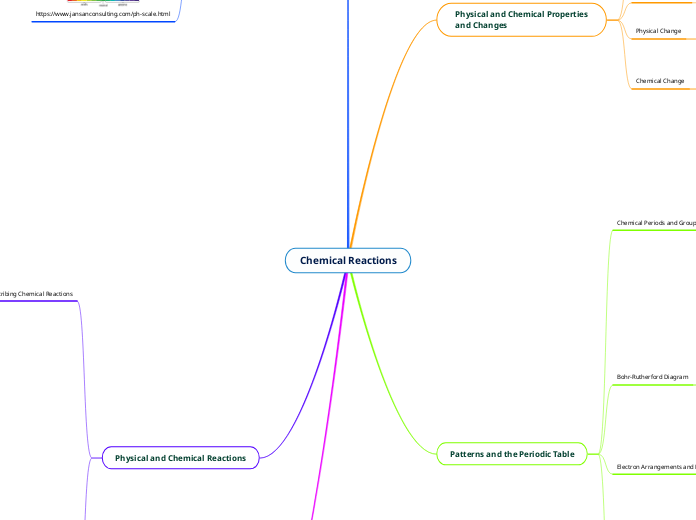Chemical Reactions
Hazardous Products and Workplace Safety
WHMIS
Materials Safety Data Sheet
Product Labels
Physical and Chemical Reactions
Conserving Mass in Chemical Reactions
Equations
The same amount of numbers, or atoms, are present
on both sides of a chemical equation
Law of Conservation of Mass
The statement that, in any given chemical
reaction, the total mass of the reactant
equals the total mass of the products
Describing Chemical Reactions
Types of Reaction
Reactants are Compounds/Elements
Double Displacement
https://byjus.com/chemistry/displacement-reactions/
Single Displacement
https://www.chemistrylearner.com/chemical-reactions/single-replacement-reaction
Reactants are Atoms/Molecules
Decomposition
https://www.teachoo.com/15535/3621/Question-32-Assertion--Reasoning/category/Solutions---CBSE-Class-10-Sample-Paper-for-2022-Boards---Science--MCQ-/
Synthesis
https://www.mt.com/se/sv/home/applications/L1_AutoChem_Applications/L2_ReactionAnalysis/synthesis-reactions.html
Terms
State Symbols
A symbol indicating the physical state of the
chemical at room temperature
Product
A chemical that is produced during a chemical reaction
Reactant
A chemical, present at the start of a reaction, that
is used up during the reaction
Chemical Equation
A way of describing the chemical reaction using the
chemical formulas of the reactants and products
Word Equation
A way of describing a chemical reaction using
the names of the reactants and products
Chemical Reaction
A process in which substances interact,
causing the formation of new substances
with new properties
Acids and Bases
pH Scale
https://www.jansanconsulting.com/ph-scale.html
Neutral
Neither acidic or basic; pH of 7
The strength of the acidity or basicity increases
by a factor of 10
A numerical scale ranging from 0-14 that is
used to compare the acidity of solutions
pH
A measure of how acidic a basic or solution is
Bases
An aqueous solution that conducts electricity
and turns red litmus paper blue
Acid-base Indicator
A substance that changes color depending on
whether it is in an acid or a base
Acids
Oxyacids
Acids that contain three elements,
Hydrogen, Oxygen and one other
Binary Acids
Always have the "Hydro" prefix and "ic acid" suffix.
Acids that contain two elements, Hydrogen and one other
An aqueous solution that conducts electricity,
tastes sour, turns blue litmus red, and neutralizes bases
Patterns and the Periodic Table
Atoms and Ions
Ion
Bonds
Covalent Bond
Diatomic Molecule
HOFBrINCl
Common diatomic molecules
A molecule consisting of only two atoms of
either the same or different elements
Molecule
A particle in which atoms are
joined by covalent bonds
A bond that results from the sharing of outer
electrons between non-metal atoms
Ionic Bond
Ionic Compounds
Names and Formulas of Ionic Compounds
Compounds formed from charged ions are electrically neutral. Therefore, equations must be balanced so that the total charges of the formula are neutral.
Naming Ionic Compounds
Metal + Non-Metal
Magnesium + Chlorine
Magnesium chloride
The first part of a name refers to the metal ion
in the compound and the second part to the non-metal.
The non-metal also has its ending changed to "ide"
Properties of Ionic Compounds
Hard, brittle, solid. Often electrolytes.
Electrolytes
A compound that separates into ions when it
dissolves in water, producing a solution that
conducts electricity
The simultaneous strong attraction of positive
and negative ions in an ionic compound
A compound made up of one or more positive
metal ions and one or more negative non-metal ions
The simultaneous strong attraction of positive and
negative ions in an ionic compound
Naming Ions
Polyatomic Ions
An ion made up of more than one
atom that acts as a single particle
Cations
A negatively charged ion
Ions
A positively charged ion
Definition
A charged particle that results when an atom
gains or loses one or more electrons
Electron Arrangements and Reactivity
Reactivity
The closer an atom is to a full electron orbit, the more stable
Compounds
A pure substance composed of two or more
elements in a fixed ratio
Bohr-Rutherford Diagram
https://schooltutoring.com/help/a-quick-start-guide-to-bohr-rutherford-diagrams/
A model representing the arrangement of
electrons in orbits around the nucleus of an atom
Chemical Periods and Groups
Noble Gases
The elements in the eighteenth column
Halogens
The elements in the seventeenth column
Alkaline Earth Metals
The elements in the second column
Alkali Metals
The elements in the first column of the periodic table
(except hydrogen)
Group
A column of elements in the periodic table
with similar properties
Period
The column number indicates the amount of valence
electrons present in a given column
A row of elements in the periodic table
Physical and Chemical Properties
and Changes
Chemical Change
Mixing baking soda with vinegar, forest fire
A change that produces a new substance
Physical Change
Example
Dissolve, cutting, melting, breaking.
A change that does not produce a new substance
Chemical Property
A description of what a substance does
as it changes into one or more new substances
Physical Property
Types
Color, texture, density, smell, solubility,
taste, melting point, physical state.
A description of a substance that does not involve
forming a new substance.









